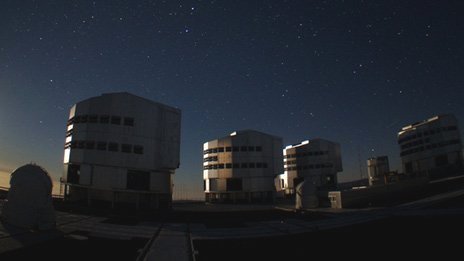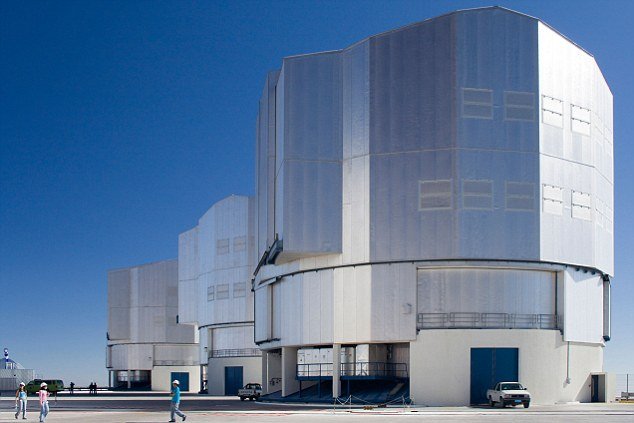A coalition of 15 states, members of European Union, has announced plans to build the biggest telescope in the world.
The mirror inside the telescope will measure 39 metres across – four times wider than today’s biggest telescope – and it will be so powerful that astronomers will even be able to observe dark, rocky planets far beyond our solar system.
The European Southern Observatory (ESO) project is supported by 15 members of the European Union and has the catchy name “European Extremely Large Telescope”… even if it will be built in Chile’s Atacama Desert, to avoid light pollution.
The twin infrared/optical telescope will sit on top of a 3,060 metre mountaintop, giving unparralled views of the sky above, and should hopefully come online in 2022.
Astronomers hope the observatory will help provide insights into the formation of galleries and the nature of black holes
They also hope to shed light on two of the biggest mysteries of our universe – the formation of “dark matter”, which cannot be directly observed but is hypothesized to make up most of the mass of the universe, and “dark energy”, which appears to driving the universe to expand at an accelerating rate.

ESO project is supported by 15 members of the European Union and has the catchy name “European Extremely Large Telescope” even if it will be built in Chile's Atacama Desert, to avoid light pollution
ESO agreed to the optical/infrared telescope in Garching, Germany, (E-ELT) Programme, pending confirmation of final referendums.
All of ESO’s member states have already expressed very strong support for the E-ELT project.
At the council meeting, Austria, the Czech Republic, Germany, the Netherlands, Sweden and Switzerland voted in favor of the start of the E-ELT programme.
Four further countries voted in favor ad referendum: Belgium, Finland, Italy, and the UK.
The project has an estimated cost of 1,083 million Euros ($1,320 million).
ESO director general, Tim de Zeeuw said: “This is an excellent outcome and a great day for ESO.
“We can now move forward on schedule with this giant project.”
2012 marks the 50th anniversary of the founding of the ESO. It is supported by 15 countries: Austria, Belgium, Brazil, the Czech Republic, Denmark, France, Finland, Germany, Italy, the Netherlands, Portugal, Spain, Sweden, Switzerland and the UK.
The team operates three observing sites in Chile: La Silla, Paranal and Chajnantor.
At Paranal, ESO operates the Very Large Telescope, the world’s most advanced visible-light astronomical observatory and two survey telescopes.
Astronomers at the Paranal observatory in Chile have created the world’s largest virtual optical telescope linking four telescopes, so that they operate as a single device.
The telescopes of the Very Large Telescope (VLT) form a virtual mirror of 130 metres in diameter.
A previous attempt to link the telescopes last March failed.
Thursday’s link-up was the system’s scientific verification – the final step before scientific work starts.
Linking all four units of the VLT will give scientists a much more detailed look at the universe than previous experiments using just two or three telescopes to create a virtual mirror.
The process that links separate telescopes together is known as interferometry.
In this mode, the VLT becomes the biggest ground-based optical telescope on earth.
Besides creating a gigantic virtual mirror, interferometry also greatly improves the telescope’s spatial resolution and zooming capabilities.

Astronomers at the Paranal observatory in Chile have created the world's largest virtual optical telescope linking four telescopes, so that they operate as a single device
The VLT is one of several telescopes in the Atacama Desert, set up by the European Southern Observatory (ESO).
ESO is an international research organization headquartered in Munich, Germany, and sponsored by 15 member countries.
Even prior to the start of the operation, as the domes of the four VLT units opened on a desert mountaintop in Chile, excitement filled the Paranal observatory’s tiny control room.
It was going to be a special night, said one of the astronomers.
The head of instrumentation at Paranal, Frederic Gonte, called the event a “milestone in our quest for uncovering secrets of the universe”.
“It’s an extremely important step because now we know that we’re ready to do real science,” Frederic Gonte said.
“From now on we’ll be able to observe things we were not able to observe before.”
To link the VLT units, the team of international astronomers and engineers used an instrument called Pionier, which replaces a multitude of mirrors with a single optical microchip.
Although the first attempt to combine the four telescopes happened in March 2011, it did not really work, said Jean-Philippe Berger, a French astronomer involved in the project.
But this time, it was already pretty clear that all the instruments were working correctly, Jean-Philippe Berger added.
“Last time, the atmospheric conditions and vibrations in the system were so bad that the data was just worthless, we stopped after half an hour knowing that it wouldn’t improve,” he said.
“So this attempt is a real first one to carry out observations for several hours straight to test the system in different conditions.”
From now on, the system will be offered to the astronomical community, he added – any astronomer working at Paranal or visiting it will be able to use it.
VLTI, or the VLT Interferometer, has been used since 2002 to link together up to three VLT telescopes, as well as four small auxiliary telescopes that reside beside the big ones on the same platform at Cerra Paranal mountain, at 2,635m altitude.
The main component of an optical telescope is a mirror, and the light coming from a particular object being observed with separate telescopes – such as a star, a nebula or a galaxy – first gets reflected off individual mirrors.
And this is where the interferometer comes into play.
It directs the light underground into tunnels, where specific instruments compensate for the delay that inevitably exists when more than one telescope is used.
Once there is no delay, the light is combined into one single beam – and the image astronomers get is what would have been produced by a single telescope with a gigantic mirror and a much better zoom.
In the case of the VLT, the zooming capability becomes almost 20 times better, said Jean-Philippe Berger.
Jean-Philippe Berger explained that although the biggest “virtual” mirror of 130 m in diameter has already been achieved by linking two farthest from each other telescopes, using all four units gives astronomers several advantages.
“The more telescopes the better – you want to generate a plane to fill that virtual mirror, to increase the efficiency to reconstruct an image, in order to observe more complex objects in the sky,” he said.
“With two telescopes, you typically observe round stars, for which you’re only interested in the diameter, or binary stars, where you can measure the separation between the two stars.
“With four telescopes, you can start thinking about triple stars or young stars surrounded by a protoplanetary disk – a disk of dust and gas that forms planets.”
“Now, the zoo of objects accessible to us will be much bigger.”
Astronomers from European Southern Observatory (ESO) have found a planet which is one of the best candidates for life ever found by telescopes on Earth.
The newly discovered planet is rocky, like Earth, and orbits its sun within the “habitable zone”, where temperatures are just right for liquid water to exist on the planet’s surface.
The temperature on the surface could be close to Earth’s.
“This planet is the new best candidate to support liquid water and, perhaps, life as we know it,” study leader Guillem Anglada-Escudé said.
The planet was detected using data from the European Southern Observatory’s telescopes, which was analyzed to look for “wobbles” in a star’s motion caused the gravitational “tug” of planets orbiting it.
The new planet has a mass around 4.5 times the Earth, and orbits a star called GJ 667C, 22 light years from Earth – just next door, in galactic terms.

Astronomers from European Southern Observatory in La Silla Paranal, Chile, South America, have found a planet which is one of the best candidates for life ever found by telescopes on Earth
The new planet absorbs around the same amount of light as our planet.
“This was expected to be a rather unlikely star to host planets. Yet there they are, around a very nearby, metal-poor example of the most common type of star in our galaxy” said Steven Vogt, a professor of astronomy and astrophysics at UCSC.
“The planet is around one star in a triple-star system. The other stars are pretty far away, but they would look pretty nice in the sky.
“The detection of this planet, this nearby and this soon, implies that our galaxy must be teeming with billions of potentially habitable rocky planets.”
“With the advent of a new generation of instruments, researchers will be able to survey many M dwarf stars for similar planets and eventually look for signatures of life in one of these worlds,” said Guillem Anglada-Escudé.
The host star is a member of a system with three stars – the other two are orange dwarf planets.
The star has a different chemical makeup than our Sun, with a much lower abundance of elements heavier than helium, such as iron, carbon, and silicon. This discovery indicates that potentially habitable planets can occur in a greater variety of environments than previously believed.
GJ 667C had previously been observed to have a large planet orbiting close to its star, although this finding was never published.
This planet orbits so close to the star that it would be too hot for liquid water. The new study started with the aim of obtaining the orbital parameters of this super-Earth.
But in addition to this first candidate, the research team found the clear signal of the new planet GJ 667C.
The team found that the system might also contain a gas-giant planet and an additional super-Earth.
However, further observations are needed to confirm these two possibilities.



